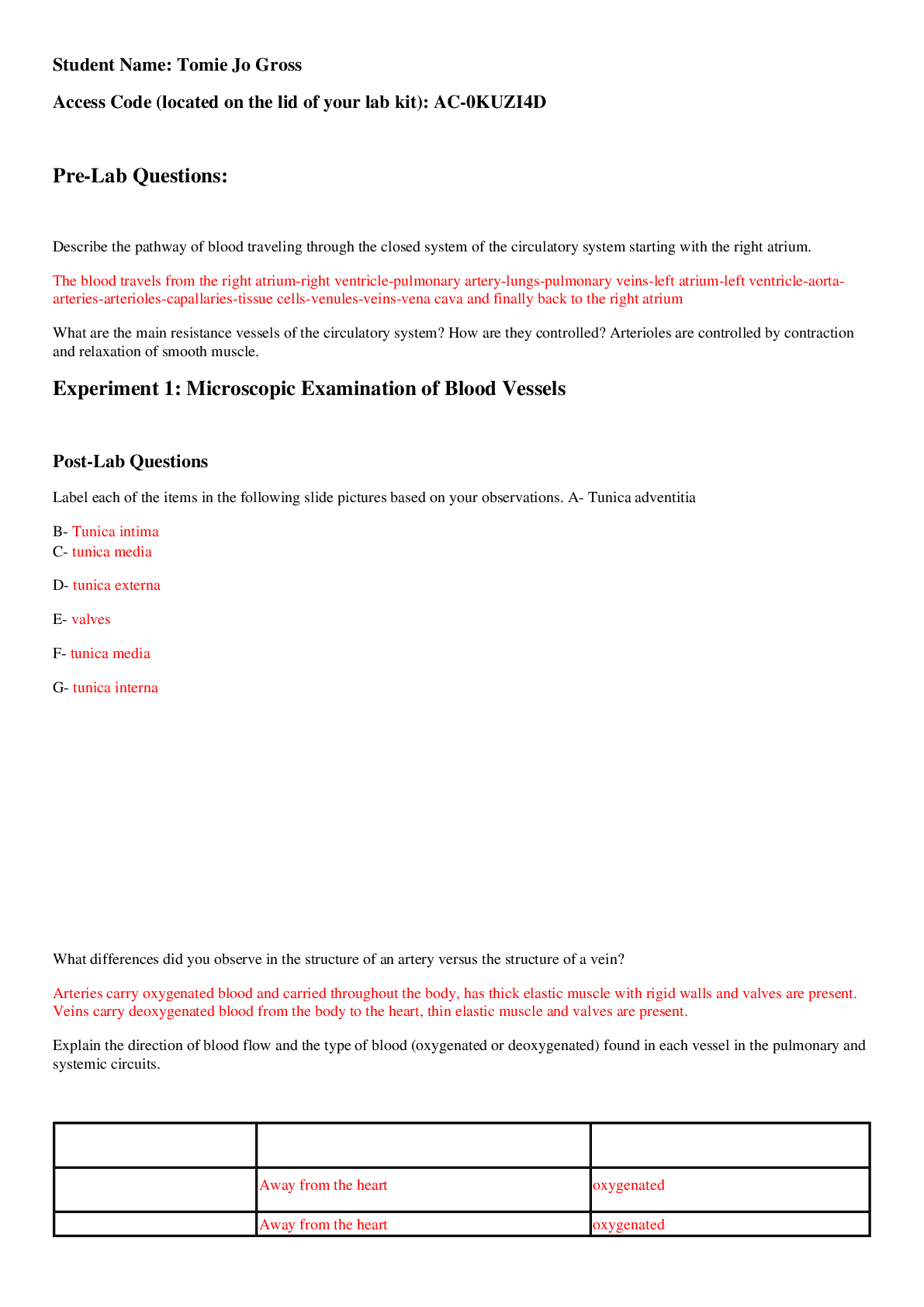Questions and Answers > Arizona State University AST 113 ASTRONOMY Lab 12
Document Content and Description Below
Arizona State University AST 113 ASTRONOMY Lab 12 Question 1 1 out of 1 points Part 1: Orbits and Classification The Jovian planets have a wealth of orbiting moons and rings. Each system has... its own unique structures, dynamics, composition, and physical features. While the Earth only has one natural satellite, the Jovian planets over 170 moons combined (at last count!). Jupiter and Saturn lead the group with over 60 moons each (67 and 62confirmed, respectively). Uranus and Neptune, however, only have 27 and 14 known moons. The orbital and physical characteristics of these moons vary widely, but some of them share common features with one another. Similar moons are placed into groups. Some moons have highly eccentric orbits, while others have nearly perfectly circular orbits. Some orbits are inclined relative to the planet’s equator, while other orbits are opposite to the rotation of the planet (retrograde motion). An orbit can take only a few hours to complete for some moons, while others may last several years. Moons of Jupiter For Jupiter, its moons are categorized based on their orbital features and distance from th The Regular Satellites of Jupiter are the moons that have nearly circular orbits with low inc Jupiter also has Irregular Satellites. These moons are much less massive than the regular satellites and retrograde paths. These moons are further categorized by their specific orbital inclination, eccentricities, largest moon in the group. formed along with it. Moons of Uranus and NeptuneUranus and Neptune both ha intimately connected to th formation. QUESTION 1 Identify the moon in Figure 1 below by clicking on the moon. Figure 1 is a close up image of Saturn's rings that was captured by the Cassini spacecraft. Figure 2. The animate image sequence in Figure 2 was acquired on April 13, 2005, at a distance of approximately 1.2 million kilometers (700,000 miles) from Saturn. The images were obtained in optical light using the Cassini spacecraft narrow-angle camera. The moon Prometheus appears first in the sequence, to the right (interior) of the ring. The moon Pandora (only 52 miles across) then appears to the left (outside) of the ring. Note also that waves of structure in the bright core of thering are visible throughout the movie. Prometheus orbits closer to Saturn, and thus faster, than the icy particles that make up the ring. The moon passes closest to the ring at "apoapse," when it is farthest from Saturn. It is during these apoapse passages that Prometheus has its greatest influence on the fine ring material. With time, the ring material previously affected falls behind so that on the next apoapse passage of Prometheus, a new core in the inner ring material is made. The material closer to Prometheus orbits the planet faster than the material closer to the bright ring core. The cores, together with the sheared-out material, create the dark, diagonal drapes. Several background stars are seen moving across the field during the movie. Image Credit: NASA/JPL/Space Science Institute QUESTION: Based on the location and size of the moons shown in Figure 2, how would you classify these two moons? Figure 3. Left image is the moon Amalthea. Right image is the moon Thebe. These images in Figure 3 of the inner Jovian moons Amalthea and Thebe were taken in January 2000 by the camera onboard NASA's Galileo spacecraft. They are the highest-resolution images ever obtained of these small, irregularly shaped satellites. The images resolve surface features as small as 2 kilometers (about 1.2 miles) across.Amalthea: Amalthea is the third moon of Jupiter in order of distance from the planet. Amalthea is in a close orbit around Jupiter and is within the outer edge of the Amalthea-Gossamer Ring, which is formed from dust ejected from its surface. Amalthea is the largest of the inner satellites of Jupiter. Irregularly shaped and reddish in color, it is thought to consist of porous water ice with unknown amounts of other materials. Its surface features include large craters and ridges. Amalthea orbits Jupiter in 0.49817943 days. Thebe: The second largest of the inner satellites of Jupiter, Thebe orbits within the outer edge of the Thebe-Gossamer ring that is formed from dust ejected from its surface. It is also irregularly shaped and reddish in color, and is thought to consist of porous water ice with unknown amounts of other materials. The prominent impact crater on Thebe is about 40 kilometers (about 25 miles) across and has been given the provisional name Zethus. Its other surface features include large craters and high mountains, some of them are comparable to the size of the moon itself. Thebe is the outermost of the inner Jovian moons, and orbits Jupiter at a distance of 221,889 km (about 3.11 Jupiter radii) in 0.674536 days. Its orbit has an eccentricity of 0.018, and an inclination of 1.08° relative to the equator of Jupiter. QUESTION: Using Kepler's 3rd law, what is the orbital distance (semimajor axis) of Amalthea from Jupiter? Hint: The quantityP2 / a3 is conserved, meaning that it is the same for both moons. P is the orbital period of a moon, and a is the semi-major axis distance between the moon and the planet. Figure 4 flips between three images from the Subaru telescope on Mauna Kea that led to the discovery of Hermippe, a moon of Jupiter. Hermippe was discovered by a team of astronomers from the Institute for Astronomy of the University of Hawaii in 2001. Hermippe is about 4 kilometres in diameter and orbits Jupiter at an average distance of 21 million kilometers in about 630 days, at an inclination of 149° to Jupiter's equator in a retrograde direction and with an eccentricity of 0.2290. Credit: S. Sheppard & D. Jewitt (2003) QUESTION: Based on these orbital parameters, how would you classify this moon? 1 out of 1 pointsFigure 5. Figure 5 shows a view of the icy surface of Jupiter's moon, Europa. It is a mosaic of two pictures taken by the Solid State Imaging system onboard the Galileo spacecraft during a close flyby of Europa on February 20, 1997. The pictures were taken from a distance of 2,000 kilometers (1,240 miles). The area shown is about 14 kilometers by 17 kilometers (8.7 miles by 10.6 miles), and has a resolution of 20 meters (22 yards) per pixel. Illumination is from the right (east). The picture is centered at about 14.8 degrees north latitude, 273.8 degrees west longitude, in Europa's trailing hemisphere. The ridge stands some 300 meters (330 yards) high. QUESTION: What geologic feature is shown crossing the image from lower left to upper right? Tidal compression deforms a warmer, ductile layer of ice below more than the cold, brittle, surface ice. This pushes up the surface ice along the length of a fracture, resulting in tilted slabs that form current double ridge shapes. Warmer ice from below is racheted up through tidal stress fractures in the surface layer of brittle ice during each tidal interaction to form growing linear ice piles along the fractures. Question 11 1 out of 1 points Given that the ridge in Figure 5 has been rising at a rate of 2 cm/yr, how long have the two sheets been moving upward since the ridge began forming? Give your answer in years and round to the nearest whole number. Selected 1 out of 1 points How does the formation in Figure 5 provide evidence for a subsurface ocean on Europa (select all that apply)?Buoyancy of the surface ice atop liquid water or an ice layer below is an explanation for the feature. Liquid water or ductile ice being deposited from an unseen reservoir below the surface is an explanation for the feature. Correct Answers: Buoyancy of the surface ice atop liquid water or an ice layer below is an explanation for the feature. Liquid water or ductile ice being deposited from an unseen reservoir below the surface is an explanation for the feature. Question 13 1 out of 1 pointsFigure 6. The curved, lined area in Figure 6 is a small part of a much larger region called Astypalaea Linea. The entire region extends over 800 kilometers (500 miles), roughly the distance of California's San Andreas fault that extends from the Mexican border to the San Francisco Bay. The image, centered at 66 degrees south latitude and 195 degrees west longitude, covers an area approximately 24 by 16 kilometers (15 by 10 miles). The resolution is 40 meters (131 feet) per pixel. The images were taken on September 26, 1998 at a range of less than 4,200 kilometers (2,600 miles) by Galileo's solid-state imaging system. QUESTION: What geologic feature is shown in Figure 6? Hint: note that the interior of the feature is generally smooth and flat, with only minor cracks.Selected Answer: A dilation band, formed from a slipping fault line. Correct Answer: A dilation band, formed from a slipping fault line. Question 14 1 out of 1 points Using the scale given in Figure 6 or recalling that the image shows a region that is 24 by 16 kilometers, how wide is the feature in the image? In Figure 6, what relative motion between the two ice sheets would explain the curved arcs seen inside the band? Selected Answer: A sliding motion in opposite directions along the band between the two ice sheets. Correct Answer: A sliding motion in opposite directions along the band between the two ice sheets. Question 16 0 out of 1 points Assuming that the ice sheets have been slowly sliding apart from each other for 358,008 years, what is the average rate of separation of the two sheets? Give your answer in cm/yr and round to the nearest decimal.Selected Bending in the fault allowed the surface to be pulled apart, which created openings that allowed warmer, softer ice from below Europa's brittle ice shell surface, or frozen water from a possible subsurface ocean, to reach the surface. This softer ice then solidified and over time, multiple layers formed the structure seen today. Correct Answer: Bending in the fault allowed the surface to be pulled apart, which created openings that allowed warmer, softer ice from below Europa's brittle ice shell surface, or frozen water from a possible subsurface ocean, to reach the surface. This softer ice then solidified and over time, multiple layers formed the structure seen today. Question 18 1 out of 1 points In Figure 6, notice the straight crack running along the band? Did this crack form before or after the formation appeared? How could the bands on Europa, such as the one shown in Figure 6, give evidence for a sub-surface ocean? Selected Answer: The subsequent layers of ice that formed in the band show that subsurface water or softer ice from below must have flowed to the surface as the two sheets separated over time. Correct Answer: The subsequent layers of ice that formed in the band show that subsurface water or softer ice from below must have flowed to the surface as the two sheets separated over time. Figure 7 Recently, Cassini scientists used gravity data collected during the spacecraft's several close passes over the south polar region of Saturn's moon Enceladus to show support for the possibility of a global sea of briney, liquid water. The data also suggested that Enceladus' rocky core is quite porous, which would allow water from the ocean to percolate into the interior. Calculations suggest that the top of the ocean lies beneath a 30 to 40 km (19 to 25 mile) thick ice shelf, and the ocean may be 10km (6.2 miles) deep at the south pole. Further studies from measurements of Enceladus's "wobble" as it orbits Saturn (called libration) strongly suggests that the entire icy crust is detached from the rocky core and therefore that a global ocean is present beneath the surface. The amount of libration implies that this global ocean is about 26 to 31 km in depth. Earth's ocean, for comparison, has an average depth of only 3.7 km. Following the Voyager encounters with Enceladus in the early 1980s, scientists postulated that it may be geologically active based on its young, reflective surface and location near the core of Saturn's E ring. Based on the connection between Enceladus and the E ring, scientists suspected that Enceladus was the source of material in the E ring, perhaps through venting of water vapor from Enceladus's interior. Observations made by Cassini in January and February 2005 confirmed that icy particles above Enceladus's south pole were being emitted from the moons surface. Figure 8.QUESTION: The water vapor plumes shown in Figure 8 provide evidence for subsurface oceans on Enceladus. Which of the statements below correctly states this interpretation of the plumes? Selected Answer: The water vapor in the plumes suggest that there must be some reservoir of liquid water that is unseen beneath the surface generating immense pressure for this water to be ejected. Correct Answer: The water vapor in the plumes suggest that there must be some reservoir of liquid water that is unseen beneath the surface generating immense pressure for this water to be QUESTION: Given that Enceladus has an average diameter of 504 km, using Figure 9, approximately how far do the plumes extend from the surface? Be sure to consider even the faintest parts of the plumes that reach about half way up the image. 1 out of 1 pointsIn physics, the escape velocity is the minimum speed needed for an object to "break free" from the gravitational attraction of a massive body. The escape velocity from earth is about 40,270 km/h (25,020 mph). For a massive celestial object (e.g., a star or planet), the escape velocity at a given distance is given by the formula: where is the escape velocity in meters per second, is the universal gravitational constant and is equal to 6.67x10-11 m3/kg/s2, is the mass of the object in kilograms, and is radius of the object in meters. QUESTION: Enceladus has a mass of 1.08x1020 kg and a radius of 2.521x105 meters. What is the minimum speed (in meters per second) that the plumes must travel to escape the gravity of Enceladus? Round to the nearest whole number. Ice particles in the plumes from Enceladus were found to be rich in sodium salt, implying that the water has been in contact with rock. Furthermore, scientists using Cassini’s Cosmic Dust Analyser, have discovered a population of tiny dust grains, just 2–8 nm in radius, in orbit around Saturn that are rich in silicon, indicating they formed in water-ice. In order for these plumes to reach their observed height and velocity above the surface, the icy plumes require high pressure and temperatures near 90º C below the surface. QUESTION: Given this information, which of the following options would be the most likely source of heat and pressure for the plumes?Selected Shown above, Io is the most geologically active object in the Solar System, with over 400 known active volcanoes. Several volcanoes produce plumes of sulfur and sulfur dioxide that climb as high as 500 km (300 mi) above the surface. Io is primarily composed of silicate rock surrounding a molten iron or iron sulfide core. Most of Io's surface is composed of extensive plains coated with sulfur and sulfur dioxide frost. Io's source of internal heat is it's tidal interactions with Jupiter and the other Galilean moons in orbital resonance with it. Since Jupiter is very massive, the side of Io nearest to Jupiter has a slightly larger gravitational pull than the opposite side. This difference in gravitationalforces cause distortion of Io’s shape. Jupiter pulls Io inward and other moons pull Io outward. This causes Io’s orbit to be elliptical and eccentric. The distance between Jupiter and Io changes constantly and the distortion of Io's shape likewise changes. The constant change in the shape of Io results in a large amount of friction in the moon and the friction-induced heating drives strong volcanic activities on the surface of Io. [Show More]
Last updated: 2 years ago
Preview 1 out of 23 pages

Buy this document to get the full access instantly
Instant Download Access after purchase
Buy NowInstant download
We Accept:

Reviews( 0 )
$9.00
Can't find what you want? Try our AI powered Search
Document information
Connected school, study & course
About the document
Uploaded On
Aug 08, 2022
Number of pages
23
Written in
Additional information
This document has been written for:
Uploaded
Aug 08, 2022
Downloads
0
Views
191
.png)

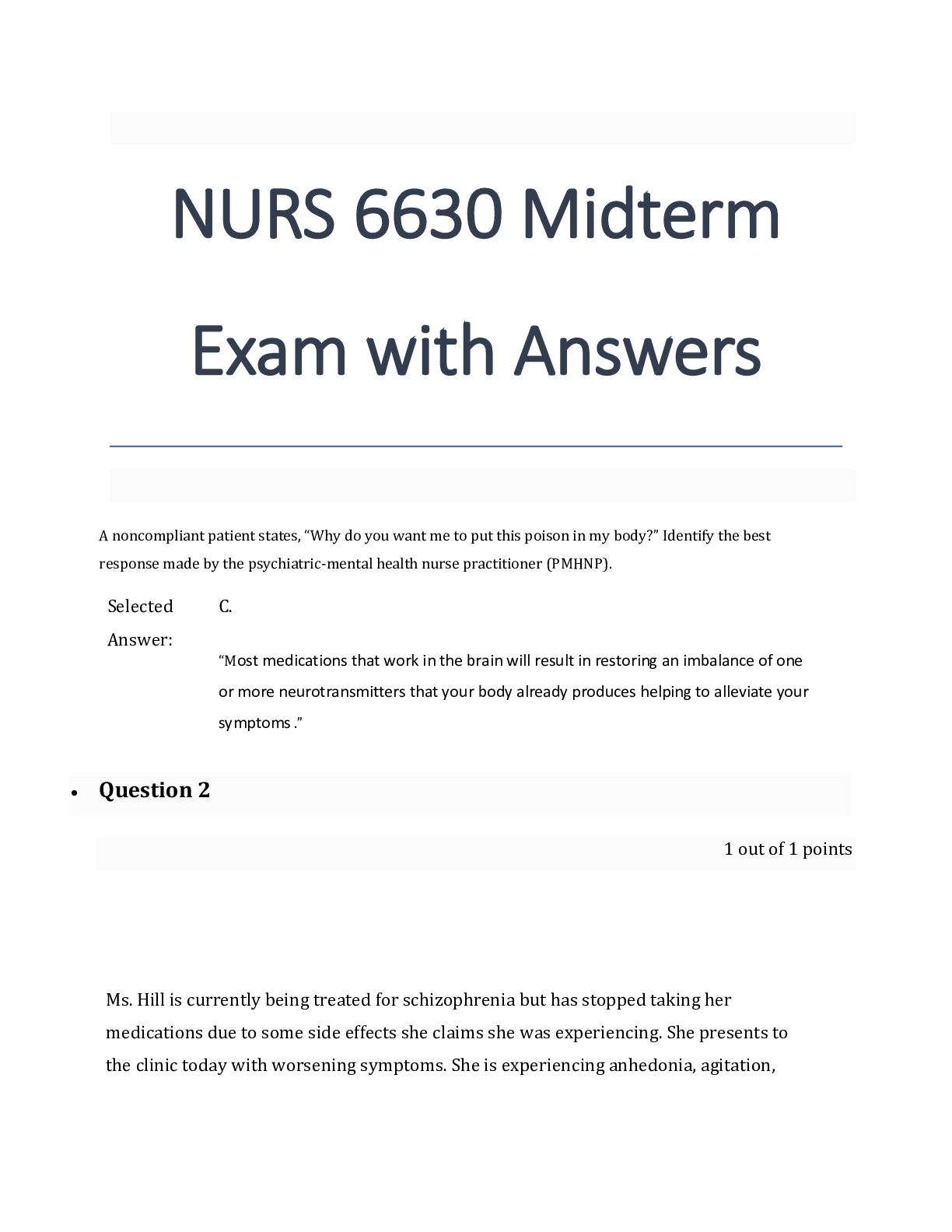

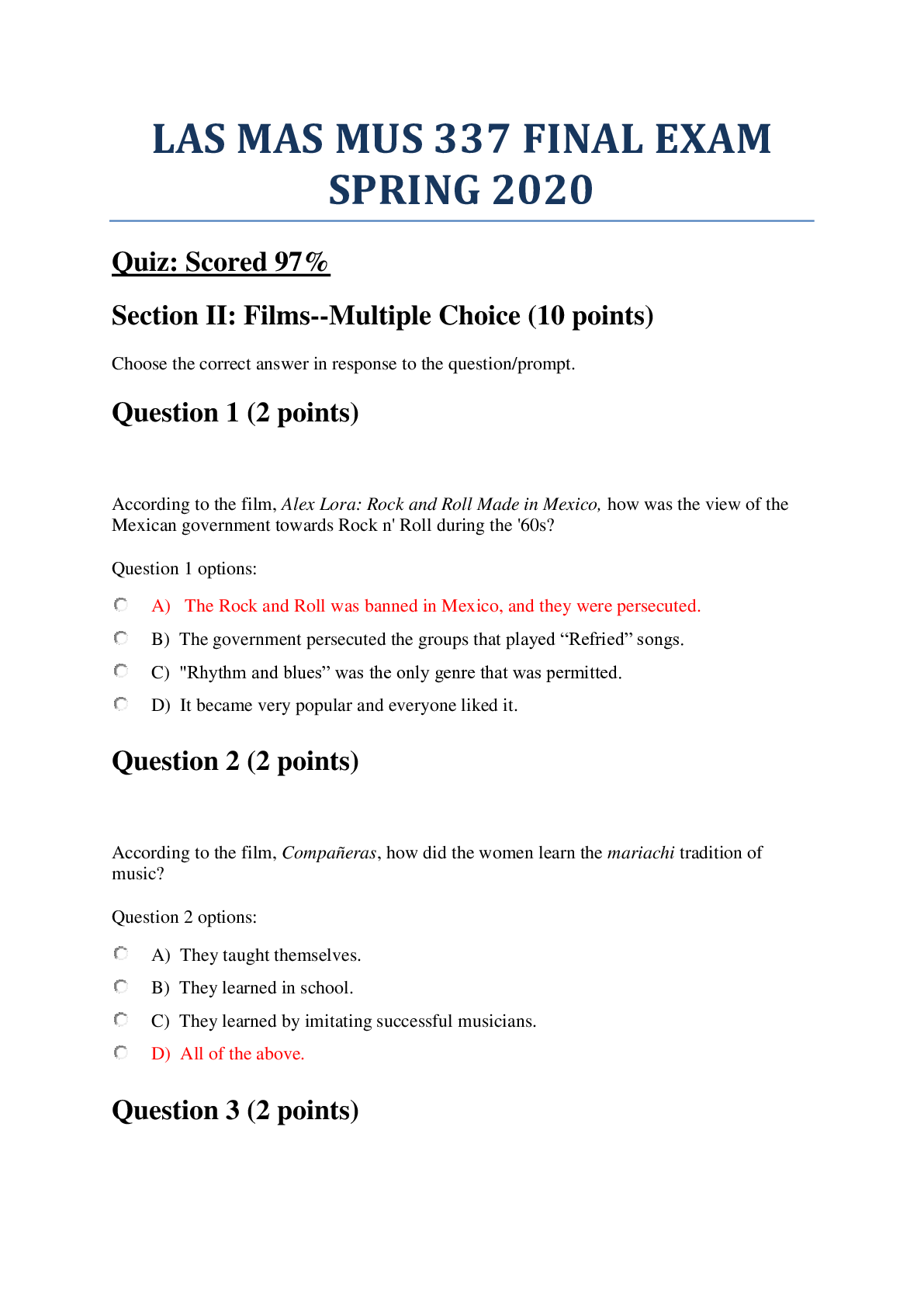




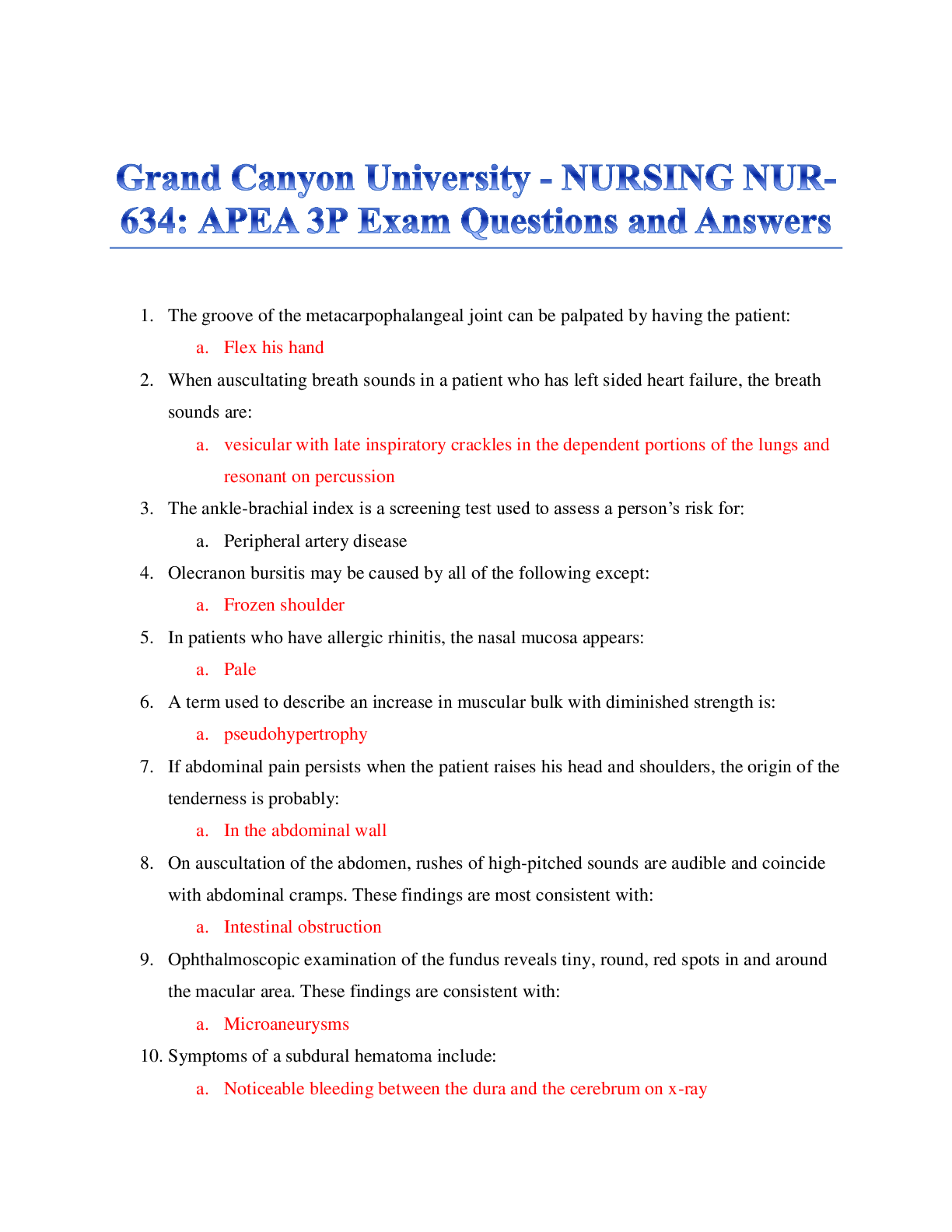
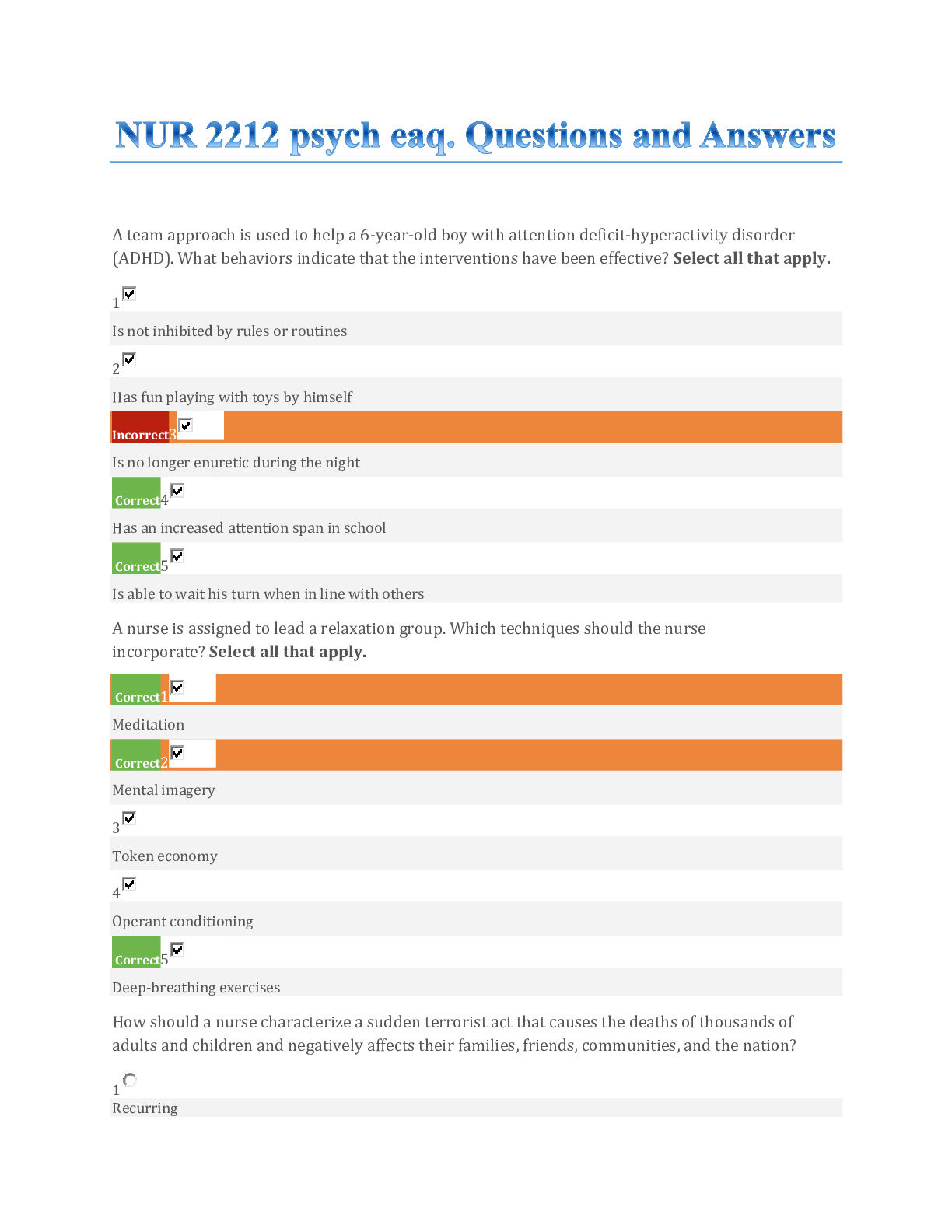



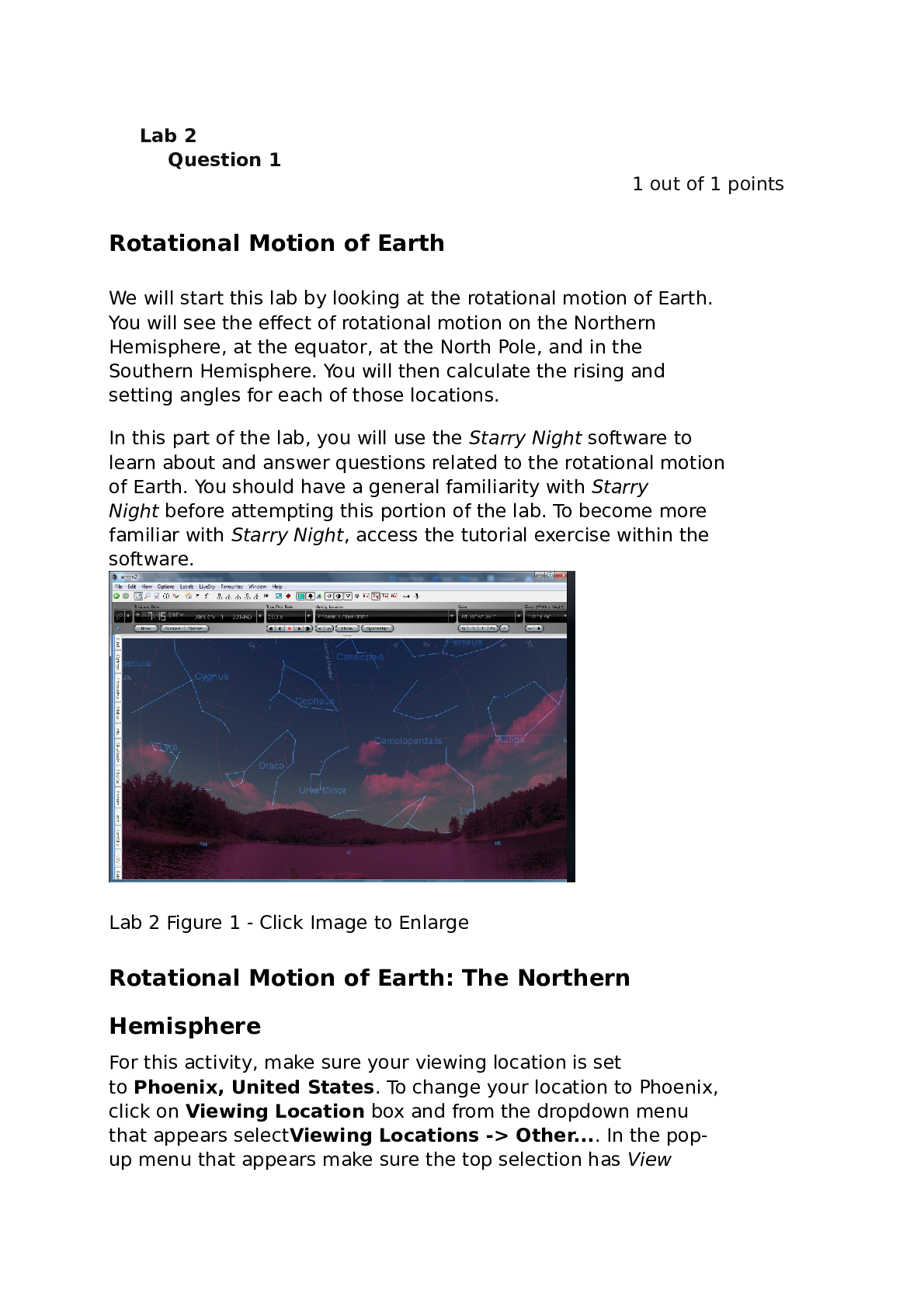
.png)





